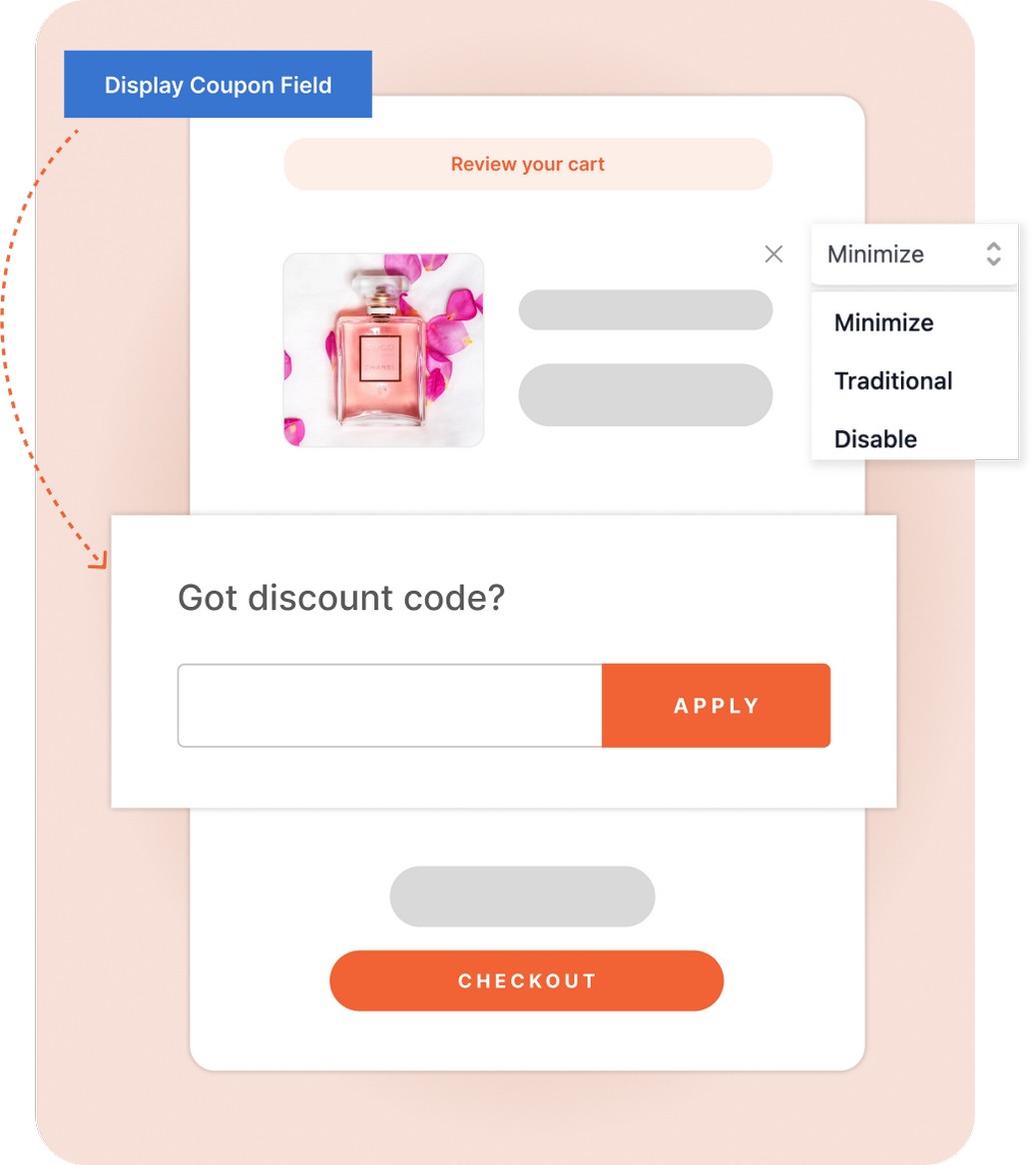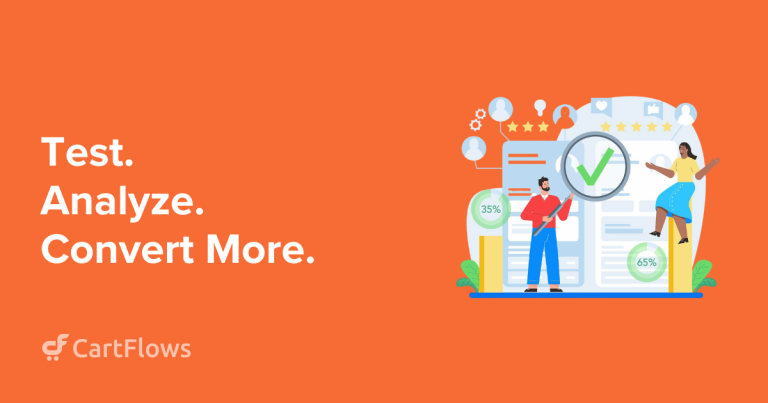Your eCommerce store has traffic and customers are clicking “buy.”
But something’s missing. Those sweet, big-ticket purchases that make revenue graphs go up and to the right.
Most online store owners obsess over attracting new customers and pour money into ads, SEO, and social media.
Meanwhile, they’re ignoring the goldmine under their noses – encouraging existing customers to spend more per order.
But your store doesn’t have to be the same.
Let’s turn your checkout process from a simple transaction into a revenue generating powerhouse.
We’re going to share 14 strategies that will boost average order value without annoying customers or interrupting their journey.
What Is Average Order Value?
Average order value (AOV) tells you how much customers spend each time they shop with you. It’s one of the most important metrics in eCommerce.
The formula is simple:
AOV = Total Revenue ÷ Number of Orders
For example, if your store made $31,000 from 1,000 orders last month, your AOV is:
$31 ($31,000 ÷ 1,000 = $31)
Unlike metrics focused on individual customers, AOV measures each transaction. This makes it perfect for testing whether your sales tactics actually work.
Why AOV Matters
Any business that cares about revenue should absolutely care about growing their average order values.
Here are some important reasons why AOV matters:
- Instant revenue boost: When customers spend more per order, you make more money without needing more visitors. This efficiency translates directly to better profit margins.
- Cost-effective growth: Think about it: acquiring new customers costs money. Ads, marketing, outreach – it adds up quickly. But getting existing customers to spend more? Much cheaper.
- Customer psychology insights: A low AOV might reveal hesitation from customers. Are they unsure? Do they lack trust? Meanwhile, a high AOV suggests confidence.
- Business performance benchmark: Tracking AOV over time helps you measure how well you’re doing. Seasonal changes, marketing campaigns, and product launches all affect AOV, giving you clear feedback on what works.
- Strategic planning tool: AOV influences crucial business decisions, including whether to offer free shipping, launch new marketing campaigns, or adjust product prices.
- Connection to other metrics: AOV works alongside conversion rate (CR) and revenue per visitor (RPV).
- Competitive advantage: A higher AOV means you’re extracting more value from each customer. This extra revenue can fund better marketing, product development, or lower prices.
Unlock the Ultimate WooCommerce Store Guide!
Want to build a successful WooCommerce store in 2025? Get our FREE, exclusive step-by-step video course created by the CartFlows team.
Ultimate WooCommerce Store Guide!
Want to build a successful WooCommerce store in 2025? Get our exclusive, step-by-step video course.
14 Strategies To Increase Average Order Value
If those benefits have convinced you that AOV is worth the effort, here are 14 strategies that you can implement starting today.
1. Product Bundling
Product bundling is a strategy that has been applied since the brick and mortar days of commerce.
Buy a combination of bundled products and get a discount on the price. This strategy is great at encouraging customers to buy more than they originally planned.
Think of how Amazon regularly suggests products that are frequently bought together.

This is Amazon’s version of bundling.
It works because they have algorithms powering the searches and a lot of user data which they can use to suggest the most relevant product.
You can do it in a much different way and still get the same AOV boosting benefits.
How to implement:
- Install the Product Bundles extension from WooCommerce
- Go to Products → Add New → select Grouped Product type
- Add your individual products to the bundle
- Set a bundle price that’s slightly lower than buying items separately
- Enable Grouped Product Display settings for optimal presentation
Bundling works because it offers convenience and value. Customers get everything they need in one click, usually at a better price than buying separately.
This removes decision fatigue and creates a win-win for both you and your customers.
2. Free Shipping Thresholds
95% of the surveyed US consumers want free shipping. So, it’s no surprise that free shipping thresholds are extremely effective at increasing the order of average values.
When a customer sees they are just $10-20 away from free shipping, they’d rather add $10 worth of product than pay $10 dollars for delivery.
And it’s not a one-to-one. Sometimes if they go back trying to add more products, they may end up adding a lot more.

How to implement:
- Go to WooCommerce → Settings → Shipping → Shipping Zones
- Add a new shipping method and select Free shipping
- Check A minimum order amount is required
- Set threshold approximately 30% above your current AOV
- Install the WooCommerce Free Shipping Bar plugin to display progress
- Configure messaging in the plugin settings
A Reddit store owner shared: “My AOV is $94. I set my free shipping threshold at $100. During free shipping promos, AOV rises to $125 and orders increase considerably.”
The psychology is clear, people hate paying for shipping more than they hate spending extra on products.
Use this quirk of human nature to your advantage!
3. Limited-Time Offers

Limited time offers induce FOMO. All you need to do is induce enough fear of missing out to push a consumer on the edge of a purchase to make a decision.
How to implement:
- Install the YITH WooCommerce Dynamic Pricing and Discounts plugin
- Create a time-limited sale under the Dynamic Pricing section
- Set start and end dates for your promotion
- Add the Checkout Countdown Timer plugin
- Place timers on product pages and cart
- Schedule email reminders
Limited-time offers work because they leverage the very powerful fear of missing out.
When customers know a deal won’t last forever, they’re more likely to act on impulse rather than risk missing out on a potential saving or good deal.
4. Loyalty Programs
Starbucks’ business model is based on loyalty programs. Once a consumer loads cash onto the membership card, they are more likely to go back and spend it with Starbucks.
Even better, Starbucks gets the money before a product is purchased. That’s the power of membership and loyalty rewards!
You may or may not be able to integrate wallets in your loyalty program depending on how large your current company is.
But you can definitely integrate loyalty discounts.
How to implement:
- Install the Advanced Coupons plugin
- Configure point values (e.g., 1 point per dollar spent)
- Create tiered rewards based on purchase values
- Set up automated emails to notify customers of points earned
- Add a points dashboard to the My Account page
- Enable point multipliers for higher-value orders
Loyalty programs tap into our desire for status and rewards.
The prospect of reaching the next tier or earning a special perk can motivate customers to add just a bit more to their orders each time.
5. One-Click Upsells and Order Bumps
Think of how large stores like Walmart and Costco keep chocolates or mini items at the checkout.
If you have been shopping for products, picking up a couple sweets at checkout becomes a mindless purchase.
These mindless purchases quickly add up for the business.
Here’s how Bathpack emulates one-click upsells and order bumps.
One click upsells aim to emulate that on eCommerce websites by showing relevant offers during checkout.
They make it incredibly easy for customers to add complementary items with minimal friction.
How to implement:
- Install CartFlows and create a one click upsell
- Select dynamic upsells that change based on the products in the cart
- A/B test static upsells where you add specific products and see which one sells better
- Try different types of upsells to find what works best for your brand or your website.
This strategy works because it catches customers when they’re already in buying mode.
They’ve decided to purchase, so they’re more receptive to related offers that enhance their original purchase.
6. A/B Testing Sales Funnels

Sales funnels are essential for guiding customers towards a purchase. But how do you know whether funnels are working or not?
Testing.
Systematic A/B testing helps identify the most effective page layouts, copy, and offers to maximize AOV.
You can create a funnel, test it and use the results of that testing to refine and improve your store.
CartFlows makes it easy with powerful split testing features built specifically for WordPress.
How to implement with CartFlows:
- Create multiple versions of your checkout flow with different upsells
- Let CartFlows automatically split traffic between versions
- Track which funnel version drives the highest AOV
- Keep the winner and continuously test new variations
CartFlows is a lot more than just another plugin. It’s designed to turn your website into a selling machine!
Over 200,000+ users already use it to help sell more on eCommerce websites. You could too!
As Troy Dean from WP Elevation noted, “CartFlows is probably the most exciting product in the WP space in recent years. Totally a game changer!”
It removes the guesswork from store optimization by providing clear, data-driven insights into what actually works.
Struggling to Get Sales? Use This Proven Funnel Building Checklist
Clicks but no customers? You might be missing the most important piece: a proper sales funnel.
Our FREE step-by-step Sales Funnel Building Checklist helps you plan, build, and optimize each stage, even if you’re a beginner.
Get Your FREE Sales Funnel Building Checklist Now!
Step-by-step guidance to help beginners build high-converting sales funnels without the guesswork.
7. Dynamic and Personalized Offers

CartFlows excels at creating personalized offer sequences based on customer behavior.
The Dynamic Offers feature turns regular order bumps and upsells into highly relevant offers that entice buyers to purchase more.
How to implement with CartFlows:
- Set up conditional upsells based on what’s in the customer’s cart
- Create multi-step checkout flows with targeted offers
- Design one-click upsell pages that convert like crazy
- Customize every aspect of the offer presentation to match your brand
As Chris Lema from Liquid Web mentioned, “CartFlows brings the post-purchase features to WooCommerce that it’s always needed!”
CartFlows’ dynamic offers work because they make customers feel understood rather than just sold to.
The right product at the right time significantly increases the chances of additional purchases, boosting your AOV without feeling pushy or aggressive.
8. Realtime Cart Updates
Modern Cart for WooCommerce transforms the standard cart experience into a sleek, interactive shopping journey with real-time updates.
As customers add or remove items, they see their cart summary update in real-time, creating a seamless experience that keeps them engaged rather than abandoning their purchase.
This frictionless experience leads to faster checkouts, higher customer satisfaction, and ultimately, more completed purchases with higher values.
How to implement with Modern Cart:
- Replace your outdated WooCommerce cart with Modern Cart’s fast, modern interface
- Enable real-time quantity adjustments without page refreshes
- Configure the cart to update totals instantly when items are added or removed
- Choose from multiple cart styles including slide-out, popup, and floating options
Modern Cart eliminates the frustration of slow-loading carts and confusing checkout flows.
Customers instantly see how their choices affect their total, available discounts, and potential savings, giving them a big-brand experience in any size of store.
9. Smart Product Recommendations

Modern Cart’s smart recommendation engine presents customers with complementary products that enhance their current selections.
These smart suggestions significantly increase the likelihood of additional purchases.
How to implement with Modern Cart:
- Enable Modern Cart’s product recommendation feature
- Show relevant items that complement what’s already in the cart
- Present suggestions that feel helpful rather than pushy
- Integrate recommendations seamlessly into the cart experience
Modern Cart makes it easy to boost average order value with relevant product suggestions.
When a customer adds a product to their cart, they instantly see related items that complement their purchase, creating natural opportunities to increase basket size.
Smart recommendations help customers discover products they might have missed while improving their overall shopping experience
It’s a win-win for both you and your customers.
10. Simplified Coupon Application

Modern Cart’s streamlined coupon system makes it incredibly easy for customers to apply discounts and instantly see their savings.
It’s easier for customers as there’s less copy and pasting. It’s easier for stores as you have more control over coupons.
How to implement with Modern Cart:
- Enable Modern Cart’s simplified coupon form
- Allow customers to enter and remove coupon codes without leaving the cart
- Make your discount process compatible with popular WooCommerce coupon plugins
- Create a frictionless discount experience that keeps customers shopping
With Modern Cart, applying discounts becomes a breeze. Customers can enter coupon codes directly in the cart and see their savings applied instantly.
This seamless coupon experience removes a major friction point during checkout, helping you convert more visitors into paying customers who spend more per order.
11. Free Shipping Progress Bar

Remember how we added the free shipping thresholds to WooCommerce? Modern Cart takes that a step further.
Modern Cart’s visually appealing progress bar shows customers exactly how close they are to qualifying for free shipping.
This simple yet powerful feature is proving incredibly effective at motivating customers to add more items to reach the threshold.
How to implement with Modern Cart:
- Enable Modern Cart’s free shipping progress bar
- Set your free shipping threshold to slightly above your current AOV
- Customize the progress bar message to match your brand voice
- Watch as customers add more items to qualify for free shipping
The psychology is simple but effective. Customers hate paying for shipping more than they hate spending extra on products.
Modern Cart’s progress bar capitalizes on this quirk of human nature by clearly showing how close they are to “winning” free shipping.
This gamified element creates a powerful incentive to add more items to their cart, significantly boosting average order value with minimal effort on your part.
12. Highlight Premium Versions (Upselling)
Upselling encourages customers to purchase higher-end versions of products they’re considering.
It’s another incredibly useful way to increase average order value without being too pushy.
For example, if the customer adds a laptop to their basket, you can highlight a faster, more expensive laptop while highlighting why it could be a better option.
If they are already in a buying mood, the chances of them choosing the more expensive option is high.
With CartFlows, you can highlight a product, or additional features and benefits and increase perceived value and justify higher prices.
How to implement:
13. Post-Purchase Cross-Sells
Post-purchase cross-selling offers complementary products immediately after a purchase.
Since customers have already committed to buying, they may be receptive to additional offers that enhance their original purchase.
How to implement:
- Present offers on the thank-you page
- Send follow-up emails with complementary suggestions
- Offer special discounts for recent customers
- Focus on accessories or consumables related to their purchase
This strategy extends the customer journey beyond the initial purchase, potentially increasing AOV across multiple transactions and building stronger relationships.
14. Social Proof and User Reviews
72% of people trust online reviews as much as real people. So there is no denying the fact that social proof is absolutely critical for eCommerce success.
Using social proof through reviews, ratings, and testimonials builds trust and confidence, especially for first time buyers.
When customers see positive experiences from others, they feel more comfortable making larger purchases.
How to implement:
- You first start with implementing the basics like star ratings, customer reviews for individual products.
- If you’re selling to brands, display the brand logos.
- We would also recommend asking for video testimonials as they are very effective
- Embed Instagram videos from people who are using your product and showing them online.
In a world saturated with marketing and sales messages, hearing from real people with real experiences is incredibly important and can make or break a purchase decision. Using Instagram IPs ban solutions can help businesses avoid access issues and keep their marketing campaigns running smoothly.
Use the power of social proof to your own advantage and watch your sales soar!
Measuring Success and Continuous Improvement
If you follow through with these tips, your website has a strong foundation to boost average order value over time.
So, how do you measure success and keep iterating on these techniques to get the most out of it?
Key Metrics to Track
Beyond overall AOV, monitor these related metrics:
- AOV by marketing channel
- AOV by product category
- AOV by customer segment
- Items per order
- Profit margin per order
Regular Analysis and Reporting
Develop a consistent reporting schedule to review AOV performance. Weekly or monthly reports help identify trends and improvement opportunities.
Marketing mix modeling can be applied to quantify the incremental impact of each marketing channel on your revenue and guide optimization decisions.
Use Google Analytics 4 (GA4) to track these metrics automatically.
Customer Feedback
Collect and analyze feedback related to your AOV strategies. This qualitative data provides insights that numbers alone can’t reveal.
Ask questions like:
- Were product recommendations helpful?
- Did the free shipping threshold motivate additional purchases?
- Did bundle offers provide enough value?
Competitive Benchmarking
Regularly compare your AOV against industry standards and competitors.
This will help you understand whether performance is exceptional or merely average, inspiring new improvement strategies.
Balancing AOV With Customer Experience
While increasing AOV matters, it should never harm customer experience. Aggressive upselling or confusing promotions can drive customers away, damaging your business long-term.
As Tony Hsieh wisely stated, “Customer service shouldn’t just be a department; it should be the entire company.”
Every AOV optimization strategy should enhance the overall customer experience, not detract from it.
The best AOV strategies feel helpful rather than pushy. They should give customers genuine value while naturally increasing their order size.
Conclusion
Increasing your AOV is one of the most cost-effective ways to boost revenue without spending more on customer acquisition.
The 14 strategies we’ve covered, from product bundling and free shipping thresholds to personalization and social proof, can significantly increase how much customers spend per transaction.
Remember to continuously test and refine while also keeping customer experience in the forefront of your mind.
So go forth, start analyzing your current average order values, and implement one or two strategies to begin with.
Then, refine and improve as you see success!
Average Order Value – Frequently Asked Questions
Average order value (AOV) is the average amount spent each time a customer places an order on your website. Calculate it by dividing your total revenue by the number of orders during a specific period (AOV = Total Revenue ÷ Number of Orders). This metric helps you understand purchasing behavior and measure the effectiveness of your pricing and marketing strategies.
You should track your average order value regularly, ideally daily or weekly for active campaigns and monthly for overall performance assessment.
Yes, discounts can reduce AOV if used poorly. Across-the-board discounts may encourage more purchases but at lower values. However, strategic discounts like volume discounts, threshold-based promotions, or premium item discounts can actually increase AOV.
Up cells and cross cells are different because upselling encourages customers to purchase a higher-end version of the product they’re considering (like suggesting a premium model with more features). Cross-selling offers complementary products that enhance the original purchase (like suggesting a case for a phone).
No, AOE and conversion rate are equally important to run a healthy business and drive revenue.
A “good” AOV varies significantly by industry, product type, pricing strategy, and target audience. There’s no universal benchmark. Rather than comparing to a generic standard, track your own AOV over time to identify trends, benchmark against specific competitors when possible, and consider your profit margins and customer acquisition costs when evaluating performance.




